
Subscribe & stay up-to-date with ASF

COMPILED BY DEIRDRE GREEN (DGREEN@ASF.CA)
Nov 4, 2022
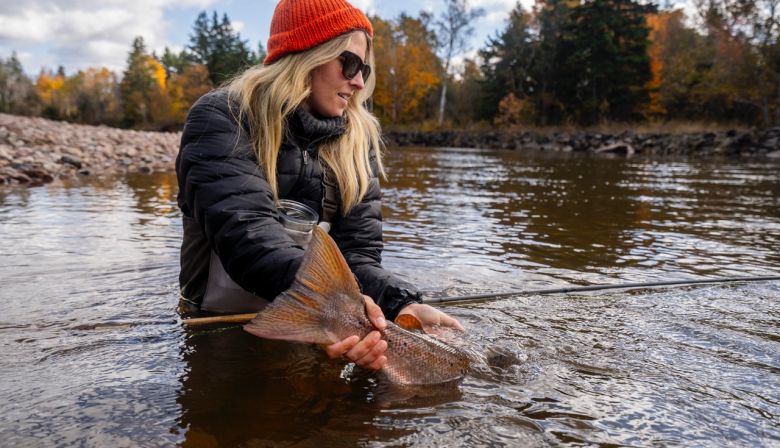
The 2022 salmon season has come to a close for all Atlantic provinces. Like many, the end of October has always been both an exciting, yet sad time. Since I began fishing, a highlight for me has most often been visiting with friends in Antigonish at Gerry Doucet’s garage — affectionately dubbed “Salmon Central” — or at Mahoney’s Beach where a wonderful group of fishy folks gather annually.
This year we shared a lovely dinner at the beach, hosted by Neil Houlding, and while at the table, conversation moved from fish tales to our individual salmon angling journeys. Listening to these legendary men and women share stories of salmon throughout the decades never ceases to amaze. But one story from last weekend resonated deeply.
Fellow angler Christine Hanlon had another incredible season and regaled us all with the story of her first Atlantic. She shared that it took her about three years to land that first salmon, and that her journey into fly fishing began when Nova Scotia still assigned four retention tags per angler. Raised by a family who ate locally caught fish like mackerel, smelt and trout, Christine planned to keep her first salmon for the dinner table. She acknowledged she was surrounded by anglers who spoke at length about the state of salmon stocks and the benefits of catch and release angling, but she remained determined to keep just one. After all, the regulations allowed it.
Everything changed when Christine held her first Atlantic salmon at Frenchman’s on West River, Antigonish. It was October and her hands were instinctually submerged in the frigid river, reviving the fish and admiring its beauty, strength and resilience. Then and there she knew this fish must continue its journey upriver to spawn. That release was just a “moment in time” Christine said, but a powerful one. It seemed to her that through osmosis she learned all she needed to, and in that brief moment of connection with a wild salmon, Christine reflected, “a catch and release angler was born”. Those who she fished with never told her what to do, but rather , they led by example. And that example resulted in another fish making its way upriver to spawn. For those of us who fish at Frenchman’s today, perhaps we have encountered the descendants of that very salmon.
Like many of my peers, when my fly fishing journey began, recreational angling for Atlantic salmon in Nova Scotia was catch and release only. However, there are a variety of aspects that are not regulated: how and when we fish during the open season, the type of barbless hooks and line we use, the photos we take (or don’t take), etc. Ultimately, how we choose to treat the salmon we connect with is how we differentiate ourselves. It’s how we can follow in the footsteps of legends and lead by example. In this way, we encourage other anglers to learn and evolve for the better. And we get to be part of those treasured “moments in time” — the most special of connections with something wild and worthy of our respect.
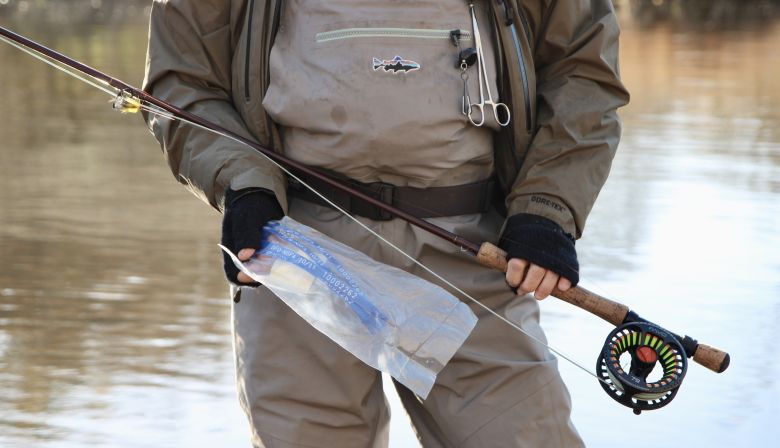

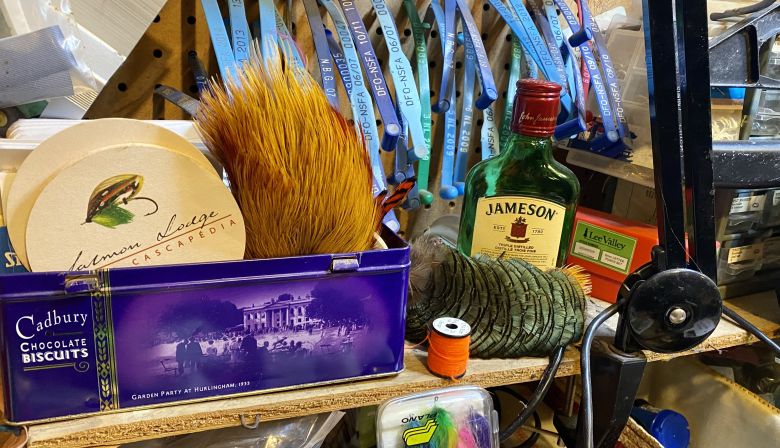
Scotty Sherin shares:
A bittersweet sadness slides over my body. My mind knows it’s time to reel up, but my hands act as detached entities. Similar to a child avoiding a bedtime, they procrastinate and continue to send my fly across the current. The light is fading fast and the river is alive with fish on the move. A true Hallows eve witching hour is coming to a close and with it the end of the 2022 Nova Scotian Salmon season. A grin creeps across my face as I recount what can only be described as an epic season full of riverside laughs, adventures, but most importantly rivers full of wild Atlantic Salmon.
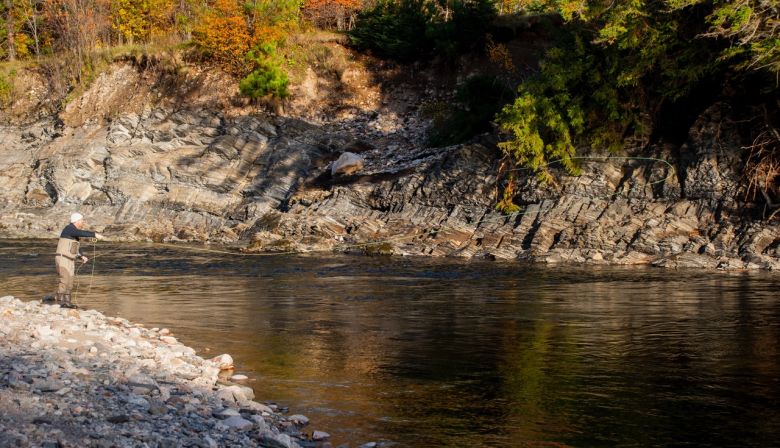
As they pack away the fishing gear to make room for vice and bobbin, Mitchell Roberts shares from their home in the South Shore a season closing story of of Nova Scotia:
This past Monday marked the end of salmon fishing season here in Nova Scotia, and I, like many others, spent the weekend on the water for one last chance at a tight line. I awoke from my home in Chester Saturday morning, and was packed and on the road by 5am. My ritual always includes a stop at Tim’s for a breakfast wrap and a cup of tea for the road.
When I arrived at the river around 7:15am, the fall air was frigid. My dashboard read -4° as I climbed out of the car to haul my waders on. I was the 4th person to arrive at the pool that day, and patiently waited my turn by the fire that had been lit.
Friends made their passes. For one man, this was his first time at this river, and he was newer to salmon fishing. I stepped in the pool behind him when it came my turn. Fish began teasing us all with rolls and jumps. The man was able to reach one, and rose the fish. He worked it for a couple more casts, and got a good hit, but wasn’t able to get a firm hookup.
The day wore on, the sun got high, and the fish got quiet. The pool became a social gathering spot, and many friends came and went through the afternoon. Reconnecting with all of these wonderful like-minded people is a huge part of what makes the sport and the community so special to me.
I spent the night at an Airbnb in a nearby town, and was able to get up early the next day. The place was near to some rivers I’d not yet fished for salmon, and I took the opportunity to explore. I quickly located some fresh fish in plain sight. Another angler and myself took turns trying to convince them, but they were coy! I was able to get a couple of fish to follow the fly for quite a distance, but no line came tight. Exciting nonetheless!
A new friend was on her way to Halifax from New Brunswick, and she asked to meet up for the afternoon. We met by a more familiar river, and set about fishing. As I worked my way behind her, I found myself into a fish!!! The bright hen took off quickly, and shot out of the air five times. Another nearby friend agreed to tail her for me. We got her close, but she was still lively and took off once more. When we got her back the second time, we thought we had her. She made a run at the last moment, and as my leader caught my friend’s jacket, I felt the line go loose. The added pressure had broken off the fly. While I was disappointed that I didn’t get to see her up close, I was so happy to have connected with her on her journey.
On the final day of the season, I packed up my Airbnb and made my way to the river once more. Seems I shouldn’t have hit snooze that last time, as two young men were in the pool, and one was tight to a fish! “Will you need my net?” I asked them. “Yeah, probably!” They said. The fight went on a while, but the fish didn’t jump while I was there. It was only when the fish got to the net that I saw the size of it. Massive. A true trophy for this river. The fish completely filled the net! The man was smiling ear to ear. His season was made ten fold!
I fished the day hard, hoping for another chance. As the sun sank further behind the trees, I knew I had only one pass left of my 2022 season. I changed tactics and flies; something different to hedge my bets. It was the right decision. The fish gods gave me another chance, and I wasn’t about to let them down. The fish put on quite the show, soaring out of the water several times. A man came up from downstream when he heard the commotion, and offered to help. He took my net, and waited patiently while the fish and I fought each other. Eventually, the fish tired enough to be landed, and I got a good look at him. Beautiful, deep colours, and a prominent kype jaw told me that this fish was just about ready for its late-fall dance. I was enamoured with him. I cradled him in my arms, head pointed upstream to revive him. He wasn’t long getting back in shape. Within a couple of minutes, he gave a great kick with his powerful tail and was off; his splash — a final parting gift.
I was beaming. I still am. I rarely get the opportunity to play two fish in as many days. This weekend was one for the books. I am completely happy to end my season on such a high note.
Now, as I put my rods on the shelf, I have time to reflect. Tying season is here, and with it comes day dreams of days gone by and days to come. I cannot wait to see what friendly faces — new and old — I encounter on my journey next season.
Follow Mitchell Roberts — a licensed Nova Scotia fishing guide, spey-casting instructor and fly tier — on Instagram @lifebetweenlines
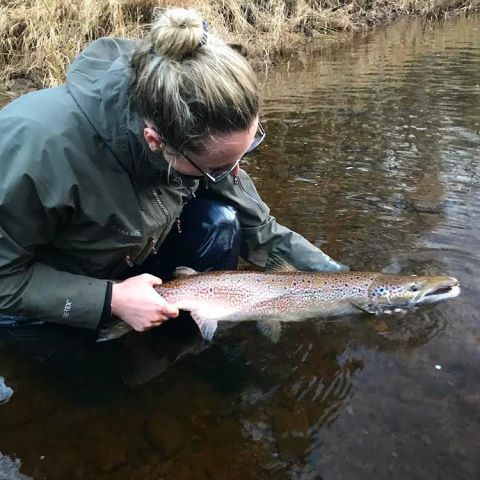
Raymond Plourde ended the season on a high note and comments:
It was the best fall season we’ve seen in Nova Scotia in several years. Consistent rains, including a big dump from Hurricane Fiona, kept water levels up throughout September and October, and returns of MSW salmon were definitely up as well. The ASF/NASF Greenland net buyout appears to be working as more fish are making it back to their rivers to spawn. The late Orri Vigfusson would be very pleased indeed.
For those who are not familiar with Orri Vigfusson — a salmon conservation hero and true pioneer — see northatlanticsalmonfund.org/orris-story to learn about his leading role in the Greenland net buyout – among others.
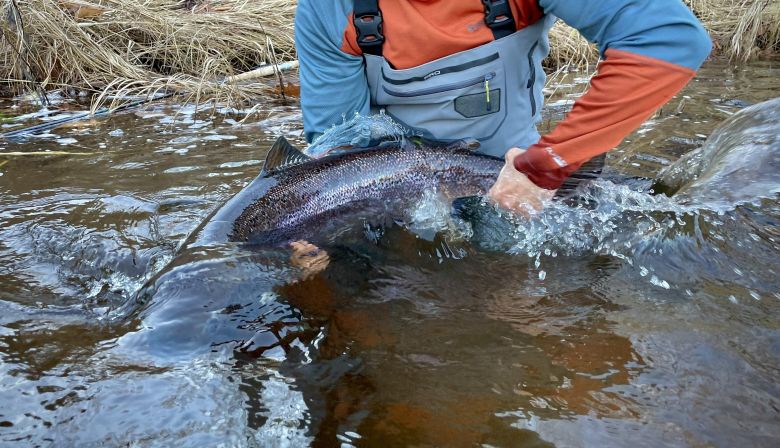

We were fortunate this fall on West River Antigonish — there were great water levels since hurricane Fiona. Fresh salmon entered the river on a regular basis and many anglers were able to handle those special, bright fall fish.
It seems returns on the river were very healthy this season which many anglers were able to take advantage of. A memorable moment for me came on the last day of the season. In the final hour, I was able to hook and release a big fall hen, alongside my long time fishing partner — a moment I will remember for a long time.
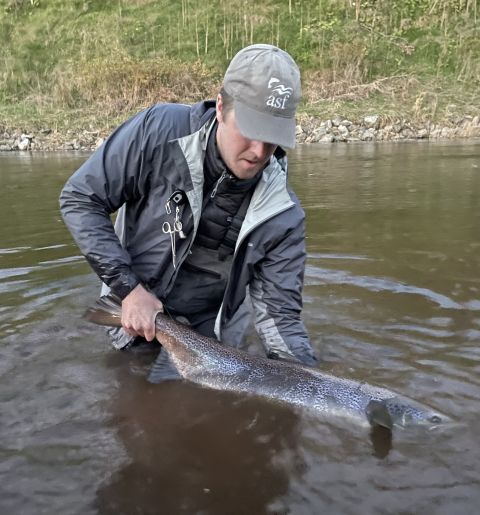
Regional Director for Wild Salmon Watersheds, Kris Hunter writes:
Don Ivany and I each recently participated in a provincial salmon symposium hosted by the Atlantic Salmon Conservation Foundation. The forum brought together watershed organizations and government officials to discuss the future of salmon conservation in Newfoundland & Labrador and New Brunswick. The forum saw several groups highlighting their current efforts, followed by panel discussions on issues facing salmon and salmon conservation and on ways forward.
These talks were a great collaborative effort that led to very informative discussions that will be helpful in improving what we do and shaping the new Wild Atlantic Salmon Conservation Strategy being developed by DFO. Thanks to the ASCF for hosting and all the other participants for a great discussion. ASCF will host a similar session in PEI later in November and in Quebec and NS in the spring of 2023. ASF will participate in each of these upcoming sessions.
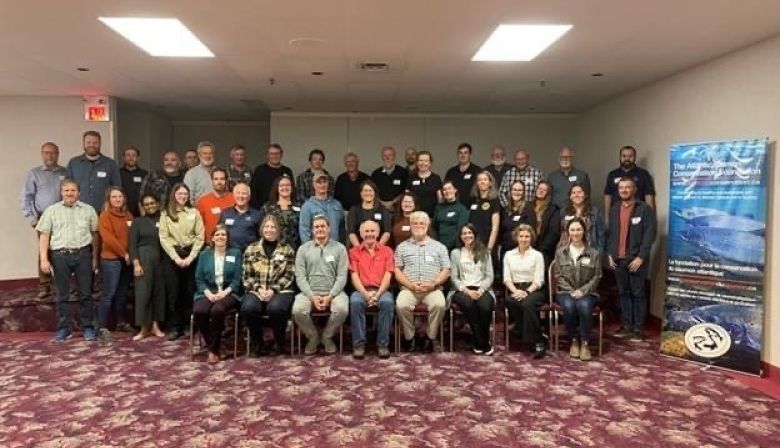
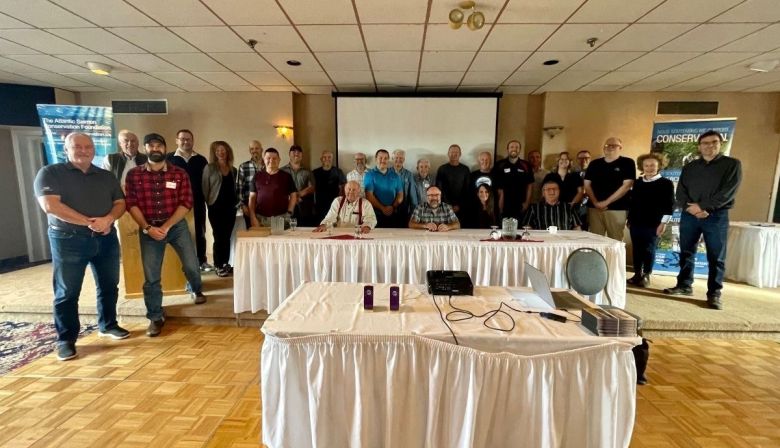
ASF’s Tom Cheney participated in a recent redd-counting event, and shares:
Anglers are packing up rods and turning their attention elsewhere, but the main event has yet to come for wild Atlantic salmon. With the days getting shorter and the water cooler, it’ll soon be spawning time. Female salmon have already started digging the nests, or redds, where they will lay their eggs.
This past weekend I took part in a redd-counting event hosted by the Nashwaak Watershed Association, the first survey on this river in 20 years. Dozens of volunteers— many whom had never seen or searched for redds before — enjoyed a beautiful Sunday afternoon on the Nashwaak tributaries. Some groups successfully spotted redds, and even those that didn’t were excited to participate in this special survey that offers a glimpse into the unique lifecycle of wild Atlantic salmon.
I took Kim and Andrew Sharpe, Humphrey Sheehan and Bryan Burgess to the upper reaches of Cross Creek, where we eyed some beautiful pools but no signs of spawning activity. We nonetheless had a great time talking about wild salmon angling and conservation.
After the survey, volunteers returned to the meeting place for food and socializing. Kids and dogs had a great time running around, while the adults sat in the sun and talked about the river. It was a great day to be part of the community of people who care about wild rivers.





Graham Chafe and Heather Perry provide the following update:
Electrofishing surveys normally take place in September, but schedules, water levels and water temperatures were such that we ended up going into October. We surveyed two sites on the Dennis, three on the Digdeguash, one on Linton Stream (a tributary of the Magaguadavic), one on the New River and one on the Pocologan. The sites we didn’t get to are up-country, the Piskahegan and Kedron streams, both tributaries of the Magaguadavic and unlikely to have salmon at this point.
The Linton Stream site is directly below a hatchery, and one site on the Digdeguash is near to a hatchery, so anything caught there is considered likely to be an accidental release/escape from the hatchery. We caught three parr on Linton, but none anywhere else. Other species captured included some beautiful brookies at Pocologan, lots of blacknosed dace, white sucker, American eel, creek chub and a banded killifish.
Much of the juveniles found in the Magaguadavic and tributaries (save Linton) in the more recent past were from enhancement releases of unfed, or first feeding fry. Once the program ended a few years ago the numbers have dropped to nothing. Very few wild or enhancement fish have returned to the river in the past five years and it is unlikely that there are sea-run salmon successfully spawning (there were a few a couple of years ago, so never say never). There is a landlocked population though.
In the other rivers, the DIgdeguash, Dennis, New and Pocologan, there are likely still populations, though we haven’t seen them recently. We used to be able to calculate parr density, but the numbers have dropped, so at this point it is a presence/absence situation.
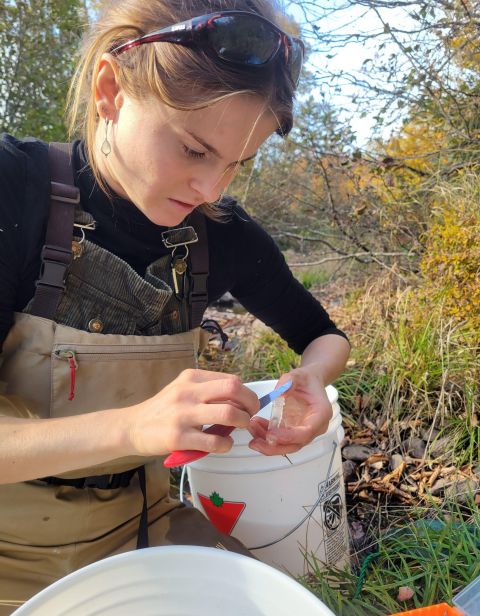

Striped bass are known predators of juvenile Atlantic salmon in the Miramichi River. ASF tracking work has shown a correlation between run timing overlap and smolt survival to the Gulf of St. Lawrence during the spring migrations. What is less known are the impacts impacts of striper predation on parr in freshwater during the fall. While large numbers of striped bass enter the Miramichi system in both spring and fall, those large numbers typically stay in the estuary. However, it is known that some do venture upstream into freshwater in the fall. Stripers have been captured in significant numbers as far upriver as the confluence with the Cains River. Reports of them being sighted, or angled much further upstream causes speculation about how far into the system they range. While the large numbers may only overlap a small portion of the parr habitat, those ranging further upstream may also have a significant impact.
The lack of data around how far upriver they range, along with how long they spend in that portion of the river and if the same individuals return year after year has led ASF to begin a tracking program to shed some light on striped bass movements in the Southwest Miramichi in the autumn. To begin to assess this issue, we began a small program in October 2022 of striped bass tagging and tracking.
Using the same acoustic equipment as our smolt and kelt tracking program, we deployed 11 receivers in the river. Two are in the main stem in the city, with French Fort Cove being the furthest downstream. In the Southwest Miramichi, eight receivers have been placed as far upstream as Hayesville, just short of Rocky Brook. This is the area of concern for tracking the striped bass, with the furthest upstream receiver where we don’t expect them to pass. If this is incorrect, we can deploy further upstream in future years. While the Southwest Miramichi is the area of interest for the project, we deployed one receiver at Eel Ground, 1km up the Northwest, to be able to discern whether tagged bass were exploring up each branch, or simply heading up one or the other.
We had planned and acquired 30 acoustic tags for 2022, but unfortunately, the timing of the large numbers of striped bass ascending to the freshwater section of the river did not overlap with our license to capture and tag. Only two fish were tagged. On our last day of tagging, October 15th, reports were that the fish were beginning to ascend the freshwater portion, but that large numbers were still in the estuary and tidal sections. We are seeking clarification and advice from DFO and may yet be able to tag some more fish this year. Though we could catch and tag many fish easily in the tidal waters, we want to tag only in the freshwater portion considering many bass do not ascend into the freshwater portion in the fall. By tagging selectively in the upriver areas, we are restricting tags to these fish proven to be in the areas of interest.
The tags being used have a life of approximately ten years. The data from these tags will also be used towards the spring assessment of striped bass predation on seaward migrating smolts. The more striped bass that are tagged, the more information on their habits and movements we can collect to assist management decisions regarding the fishery and impacts on Atlantic salmon, as well as forage fish in the Miramichi River.
Maranda Nemeth writes:
As the temperatures have dropped and rain brings the rivers up, spawning is on across the state. Maine Department of Marine Resources (DMR) is ctively counting redds made from wild salmon in the rivers.


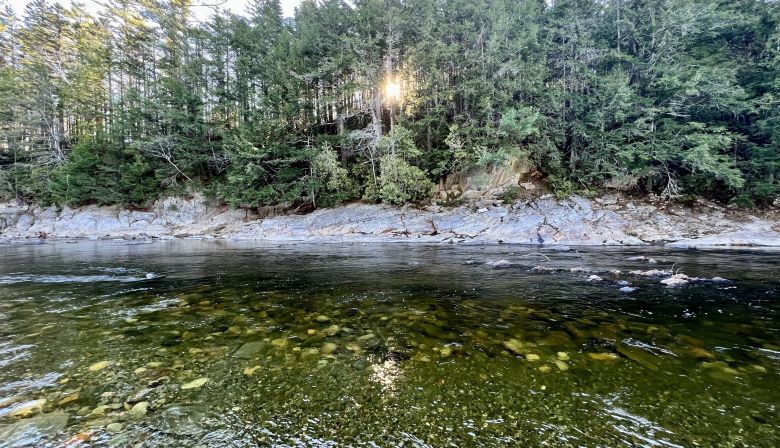
Fisheries and Oceans is looking for your comments on their online Atlantic salmon and striped bass recreational fisheries questionnaire:
Complete the online survey HERE.
This survey helps determine management measures for both species. As always, your help is greatly appreciated.
Fisheries and Oceans Canada (DFO) is seeking your help to support the Government of Canada’s commitment to develop the first-ever Wild Atlantic Salmon Conservation Strategy (WASCS). The online survey opened on October 11, 2022 and will close to new input on November 18, 2022.
If you have questions, please reach out to anyone at ASF. Your voice matters and we strongly encourage you to offer your input before November 18th.
